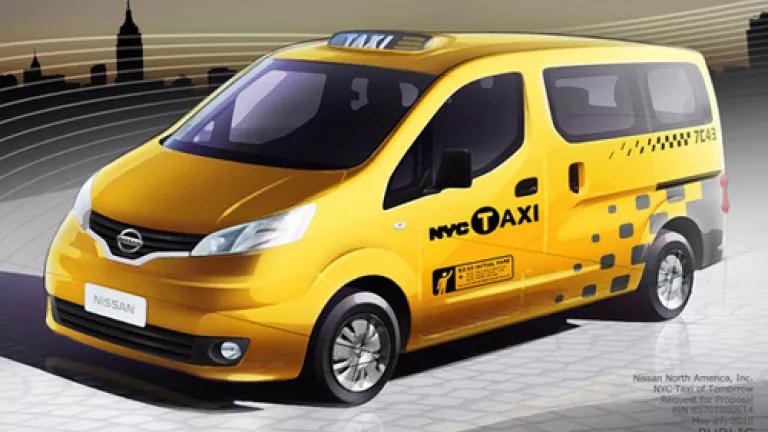
Earlier today, Mayor Bloomberg announced that New York City has chosen the Nissan NV200 as the winner of its Taxi of Tomorrow competition. The new vehicle – once the final contract is worked out and likely lawsuits are resolved – would become the single model for NYC’s more than 13,000 taxis.
From an environmental perspective, the new design is a step backward from the current hybrid cabs on the road, but the Mayor’s announcement offers some hope that over the next decade, the city will move towards an even greener vehicle: an all-electric taxi.
The Nissan was chosen from three competing designs and unfortunately not one, including the winning taxi, is a hybrid (gasoline-electric) car. Thus, at least in the short term, this decision undercuts Mayor’s efforts to green New York’s taxi fleet by improving fuel economy and reducing harmful tailpipe emissions. Over the last six years, the number of New York City yellow hybrid taxis has climbed to around 4,300 cars – or roughly 35 percent of the total fleet – thanks to the Mayor’s successful efforts to promote hybrid cabs. NRDC played a critical role – alongside the Mayor and Taxi and Limousine Commissioner David Yassky – in implementing the reforms that permitted taxi owners to use cleaner hybrids for the first time.
Unfortunately, the city's effort to expand the use of hybrid taxis through strong financial incentives was blocked by federal court rulings that held that the city’s approach infringed on Congress’s authority to regulate air quality and fuel efficiency standards for cars.
Because of these rulings, the city could not select Taxi of Tomorrow designs based on meeting certain environmental and fuel efficiency standards. And that is likely one reason Nissan – as well as the two other finalists, Ford and Karsan – did not offer a hybrid as the first car in their proposals.
Still, there are some gains for riders and drivers:
- Double the fuel efficiency of Crown Victorias: The NV200 gets roughly double the gas mileage (25 mpg) of the Ford Crown Victoria, which will soon go out of production.
- Electric taxi pilot program: Additionally, Nissan indicated it will be able to manufacture an electric-only version of the NV200 in 2017 and that starting right away it will launch a six-taxi pilot program of fully electric Nissan LEAFs.
- Safety & comfort: And it incorporates significant comfort and safety features, including passenger airbags and sliding doors to eliminate the "dooring" of passing cyclists, pedestrians, and vehicles.
But there’s certainly room for improvement: In order to ultimately make the Taxi of Tomorrow program an environmental success, the Bloomberg Administration should keep the existing hybrid taxis on the road as long as possible, focusing first on phasing out the dirtiest cabs. Under the current timeframe, the initial Nissan NV200s would be on the road in 2013 and the entire remaining fleet would be converted by 2018.
At the same time, the Administration must work with Nissan to roll-out hybrid versions of the NV200 over the next few years and then pivot to an all-electric model by 2017. And, of course, there must be mechanisms to encourage taxi owners to buy both the hybrid and all-electric models once they are available. Doing so will allow the city to continue to be a national leader on green taxis, given that San Francisco and San Jose are reportedly poised to adopt their own electric taxi programs.
And while advancing the Taxi of Tomorrow program, the Mayor should also demonstrate his commitment to cleaner cars by supporting the national GO60 MPG campaign to make 60 MPG the standard for ALL new U.S. vehicles – including the yellow taxis – by 2025.
In short – our hope is that Deputy Mayor Stephen Goldsmith’s statement rings true that today they are “announcing not the end of a process, but the beginning.” By taking steps to strengthen the sustainability of the Taxi of Tomorrow program, Mayor Bloomberg will be able to help cement his green taxi legacy and, as stated in his newly revised PlaNYC, help “achieve the cleanest air quality of any big U.S. city,” right here in New York.
We have a few ways you can keep up with New York work online: Please visit our website at www.nrdc.org/newyork or follow us on Facebook and Twitter.

